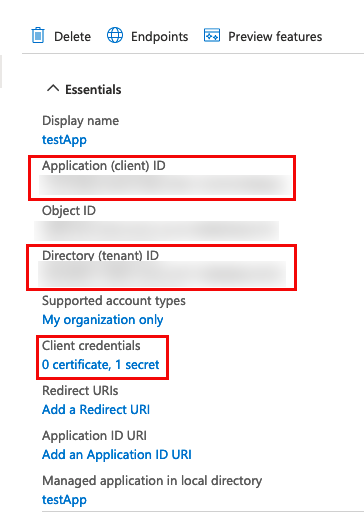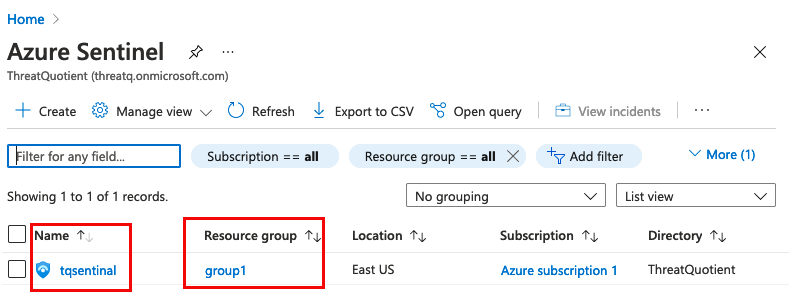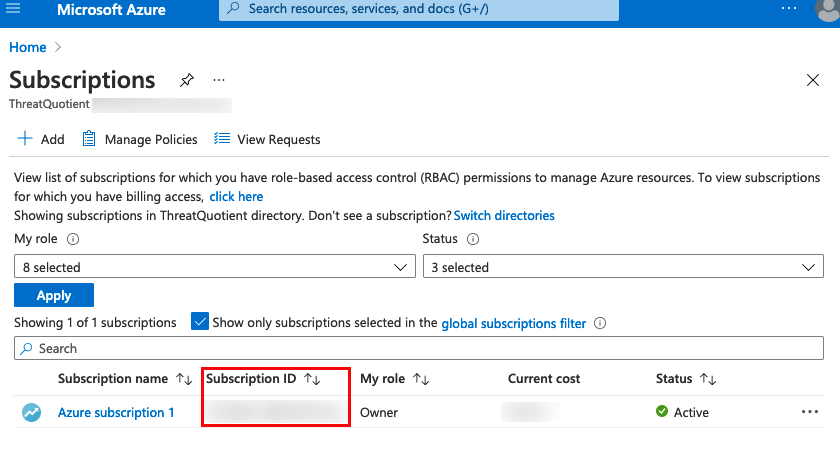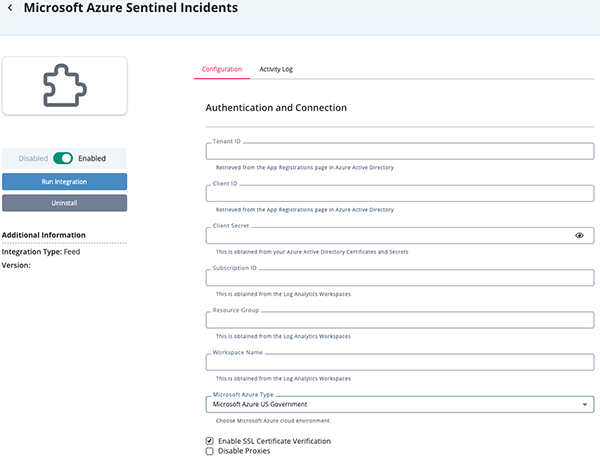ThreatQ CDF for Microsoft Azure Sentinel Incidents
The web format of this guide reflects the most current release. Guides for older iterations are available in PDF format.
Integration Details
ThreatQuotient provides the following details for this integration:
| Current Integration Version | 1.2.3 |
| Compatible with ThreatQ Versions | >= 4.37.0 |
| Support Tier | ThreatQ Supported |
Introduction
Sentinel is a project of Microsoft Azure with the goal of alerting SOCs of potential compromise. The ThreatQ CDF for Microsoft Azure Sentinel Incidents retrieves those incidents.
The Microsoft Azure Sentinel Incidents CDF provides the following feeds:
- Microsoft Azure Sentinel Incidents - retrieves a list of incidents.
- Microsoft Azure Sentinel - Authentication (supplemental) - authenticates against Sentinel.
- Microsoft Azure Sentinel - Incidents Relations (supplemental) - retrieves all relations for a given incident.
- Microsoft Azure Sentinel - Entity Details (supplemental) - retrieves context for each entity related to an incident in the incident list by expanding the entity.
- Microsoft Azure Sentinel - Entity Indicators (supplemental) - retrieves a list of indicators, emails, malware and attributes for each entity related to an incident in the incident list.
The integration ingests the following system objects into the ThreatQ platform:
- Incidents
- Indicators
To acquire required app permissions, the app registration must have the proper API permissions. See the Prerequisites section for more details.
The scope for authentication is https://management.azure.com/.default which means non-standard practices for authentication are required.
Prerequisites
The following is required in order to install and configure the integration.
- Register your ThreatQ integration for the Azure portal - see https://learn.microsoft.com/en-us/azure/azure-monitor/logs/api/register-app-for-token for more details and instructions.
- Apply Graph API permissions.
- Apply the Microsoft Contributor Role.
- Locate all required credentials for the configuration page.
Applying Graph API Permissions
- Navigate to your Azure App Registrations portal and open the ThreatQ integration app.
You can also search for
App Registrationsand then select the first option. - Open the ThreatQ integration App's configuration page.
- Open the API Permissions tab located on the sidebar.
- Click on the Add a Permission button.
- Select the Microsoft Graph API.
- Click on the Application Permissions option.
- Search for
ThreatIndicatorsand enable theThreatIndicators.ReadWrite.OwnedByentry. - Search for
SecurityAlertand enable theSecurityAlert.ReadWrite.Allentry. - Click on Add Permissions to add the two entries that have been enabled.
Applying the Microsoft Contributor Role
The Microsoft Sentinel Contributor role should be assigned to application if you are using Microsoft Azure US Government Cloud environment.
- Navigate to your Azure App Registrations portal and open the Log Analytics workspace.
You can also search for
Log Analytics workspacesand then select the first option. - Open the workspace that contains your Microsoft Sentinel instance.
- Click on the Access Control (IAM) tab.
- Click on the Add dropdown and select the Add Role Assignment option.
- Search for
Microsoft Sentinel Contributorin the Add Role wizard and then click on Next. - Click on the Select Members button to open the search modal.
- Use the search modal to search for your ThreatQ app registration.
- Use the Select button to select the ThreatQ app.
- Click on the Review + Assign button.
- Review the assignment and then click on the Review + Assign button again.
- You will now be able to see the role assignment you just added.
This information will not be accessible from the App's configuration page.
Required Credential Locations
The integration requires the following values when configuring the feeds:
| Parameter | Description | Example |
|---|---|---|
| Tenant ID | The Tenant ID can be found under Azure Services > App Registration > Your App name. |  |
| Application (client) ID | The Application (client) ID can be found under Azure Services > App Registration > Your App name. | |
| Client Secret | The Client Secret can be found under Azure Services > App Registration > Your App name. | |
| Workspace & Resource Group | The Workspace & Resource Group can be found under Azure Sentinel. |  |
| Subscription ID | The Subscription ID can be found by clicking on the Subscriptions option under the Azure Services heading on the main Microsoft Azure landing page. |  |
Installation
Perform the following steps to install the integration:
The same steps can be used to upgrade the integration to a new version.
- Log into https://marketplace.threatq.com/.
- Locate and download the integration file.
- Navigate to the integrations management page on your ThreatQ instance.
- Click on the Add New Integration button.
- Upload the integration file using one of the following methods:
- Drag and drop the file into the dialog box
- Select Click to Browse to locate the integration file on your local machine
- Select the feed(s) to install, when prompted, and then click Install.
ThreatQ will inform you if the feed already exists on the platform and will require user confirmation before proceeding. ThreatQ will also inform you if the new version of the feed contains changes to the user configuration. The new user configurations will overwrite the existing ones for the feed and will require user confirmation before proceeding.
- The feed(s) will be added to the integrations page. You will still need to configure and then enable the feed.
Configuration
ThreatQuotient does not issue API keys for third-party vendors. Contact the specific vendor to obtain API keys and other integration-related credentials.
To configure the integration:
- Navigate to your integrations management page in ThreatQ.
- Select the OSINT option from the Category dropdown (optional).
If you are installing the integration for the first time, it will be located under the Disabled tab.
- Click on the integration entry to open its details page.
- Enter the following parameters under the Configuration tab:
Parameter Description Tenant ID The Tenant ID can be found under Azure Services > App Registration > Your App name. Client ID The Application (client) ID can be found under Azure Services > App Registration > Your App name. Client Secret The Client Secret can be found under Azure Services > App Registration > Your App name. Subscription ID The Subscription ID can be found by clicking on the Subscriptions option under the Azure Services heading on the main Microsoft Azure landing page. Resource Group The Resource Group can be found under Azure Sentinel. Workspace Name The Workspace can be found under Azure Sentinel. Microsoft Azure Type Select the Microsoft Azure cloud environment. Options include: - Microsoft Azure Global
- Microsoft Azure US Government
Enable SSL Certificate Verification Enable or disable verification of the server's SSL certificate. Disable Proxies Enable this option if the feed should not honor proxies set in the ThreatQ UI. Severity The severity of the incidents. Options include: - High
- Medium
- Low
- Unknown
- Informational
You can select more than option severity option.

- Review any additional settings, make any changes if needed, and click on Save.
- Click on the toggle switch, located above the Additional Information section, to enable it.
ThreatQ Mapping
Microsoft Azure Sentinel Incidents
Retrieves a list of incidents.
Microsoft Azure Global - GET https://management.azure.com/subscriptions/{subscriptionId}/resourceGroups/{resourceGroupName}/providers/Microsoft.OperationalInsights/workspaces/{workspaceName}/providers/Microsoft.SecurityInsights/incidents?api-version=2024-04-01-preview&$filter=(properties/lastModifiedTimeUtc ge {since} and properties/lastModifiedTimeUtc le {until})&$top=100
Microsoft Azure US Government - GET https://management.usgovcloudapi.net/subscriptions/{subscriptionId}/resourceGroups/{resourceGroupName}/providers/Microsoft.OperationalInsights/workspaces/{workspaceName}/providers/Microsoft.SecurityInsights/incidents?api-version=2024-04-01-preview&$filter=(properties/lastModifiedTimeUtc ge {since} and properties/lastModifiedTimeUtc le {until})&$top=100
Sample Response:
{
"value": [
{
"id": "/subscriptions/XXXXXXXX-XXXX-XXXX-XXXX-XXXXXXXXXXXX/resourceGroups/XXXX/providers/Microsoft.OperationalInsights/workspaces/XXXX/providers/Microsoft.SecurityInsights/incidents/73e01a99-5cd7-4139-a149-9f2736ff2ab5",
"name": "73e01a99-5cd7-4139-a149-9f2736ff2ab5",
"type": "Microsoft.SecurityInsights/incidents",
"etag": "\"0300bf09-0000-0000-0000-5c37296e0000\"",
"properties": {
"lastModifiedTimeUtc": "2019-01-01T13:15:30Z",
"createdTimeUtc": "2019-01-01T13:15:30Z",
"lastActivityTimeUtc": "2019-01-01T13:05:30Z",
"firstActivityTimeUtc": "2019-01-01T13:00:30Z",
"description": "This is a demo incident",
"title": "My incident",
"owner": {
"objectId": "2046feea-040d-4a46-9e2b-91c2941bfa70",
"email": "john.doe@contoso.com",
"userPrincipalName": "john@contoso.com",
"assignedTo": "john doe"
},
"severity": "High",
"classification": "FalsePositive",
"classificationComment": "Not a malicious activity",
"classificationReason": "IncorrectAlertLogic",
"status": "Closed",
"incidentUrl": "https://portal.azure.com/#icon/Microsoft_Azure_Security_Insights/Incident/subscriptions/XXXXXXXX-XXXX-XXXX-XXXX-XXXXXXXXXXXX/resourceGroups/XXXX/providers/Microsoft.OperationalInsights/workspaces/XXXXX/providers/Microsoft.SecurityInsights/incidents/73e01a99-5cd7-4139-a149-9f2736ff2ab5",
"incidentNumber": 3177,
"labels": [],
"relatedAnalyticRuleIds": [
"/subscriptions/XXXXXXXX-XXXX-XXXX-XXXX-XXXXXXXXXXXX/resourceGroups/XXXX/providers/Microsoft.OperationalInsights/workspaces/XXXXX/providers/Microsoft.SecurityInsights/alertRules/fab3d2d4-747f-46a7-8ef0-9c0be8112bf7",
"/subscriptions/XXXXXXXX-XXXX-XXXX-XXXX-XXXXXXXXXXXX/resourceGroups/XXXX/providers/Microsoft.OperationalInsights/workspaces/XXXXX/providers/Microsoft.SecurityInsights/alertRules/8deb8303-e94d-46ff-96e0-5fd94b33df1a"
],
"additionalData": {
"alertsCount": 0,
"bookmarksCount": 0,
"commentsCount": 3,
"alertProductNames": [],
"tactics": [
"Persistence"
]
}
}
}
]
}ThreatQuotient provides the following default mapping for this feed:
| Feed Data Path | ThreatQ Entity | ThreatQ Object Type or Attribute Key | Published Date | Examples | Notes |
|---|---|---|---|---|---|
| 'Sentinel Incident' + .value[].properties. incidentNumber + ':' + .properties. alertDisplayName + '(Alerts:' + .value[].properties. additionalData.alertsCount + ')' |
Incident. Value |
N/A | .value[].properties. createdTimeUtc |
Sentinel Incident 3177: High Severity (Alerts: 1)) | .properties.alertDisplayName is obtained by Microsoft Azure Sentinel - Entity Details supplemental feed |
| .value[].properties.description | Incident. Description |
N/A | .value[].properties. createdTimeUtc |
This is a demo incident | N/A |
| .value[].properties. firstActivityTimeUtc |
Incident. Started_at |
N/A | .value[].properties. createdTimeUtc |
08/18/2021 12:30 | N/A |
| .value[].properties. lastActivityTimeUtc |
Incident. Ended_at |
N/A | .value[].properties. createdTimeUtc |
08/18/2021 12:43 | N/A |
| .value[].properties. additionalData.alertsCount |
Incident. Attribute |
Alert Count | .value[].properties. createdTimeUtc |
10 | N/A |
| .value[].properties.severity | Incident. Attribute |
Severity | .value[].properties. createdTimeUtc |
High | Updatable |
| .value[].properties. incidentUrl |
Incident. Attribute |
Incident URL | .value[].properties. createdTimeUtc |
https://portal.azure.com/ #asset/Microsoft_Azure_ Security_Insights/Incident/ subscriptions/XXXXXXXX-XX XX-XXXX-XXXX-XXXXXXXXXXXX/ resourceGroups/XXXX/provi ders/Microsoft.OperationalI nsights/workspaces/XXXXX/ providers/Microsoft.Securit yInsights/incidents/73e01a99-5cd7-4139-a149-9f2736ff2ab5 |
N/A |
| .value[].properties. owner.assignedTo |
Incident. Attribute |
Assigned to | .value[].properties. createdTimeUtc |
John Doe | Updatable |
| .value[].properties.status | Incident. Attribute |
Status | .value[].properties. createdTimeUtc |
Closed | Updatable |
In order to call the Microsoft Azure Sentinel - Incidents Relations supplemental feed .value[].name is used as incidentId parameter.
Microsoft Azure Sentinel - Authentication (supplemental)
Supplemental feed which authenticates against Sentinel.
Microsoft Azure Global - POST https://login.microsoftonline.com/{tenant_id}/oauth2/v2.0/token
Microsoft Azure US Government - POST https://login.microsoftonline.us/{tenant_id}/oauth2/v2.0/token
Sample Response:
{
"token_type": "Bearer",
"expires_in": 3599,
"ext_expires_in": 3599,
"access_token": "This would be your access token"
}Microsoft Azure Sentinel - Incidents Relations (supplemental)
Supplemental feed which retrieves all relations for a given incident.
Microsoft Azure Global - GET https://management.azure.com/subscriptions/{subscriptionId}/resourceGroups/{resourceGroupName}/providers/Microsoft.OperationalInsights/workspaces/{workspaceName}/providers/Microsoft.SecurityInsights/incidents/{incidentId}/relations?api-version=2024-04-01-preview
Microsoft Azure US Government - GET https://management.usgovcloudapi.net/subscriptions/{subscriptionId}/resourceGroups/{resourceGroupName}/providers/Microsoft.OperationalInsights/workspaces/{workspaceName}/providers/Microsoft.SecurityInsights/incidents/{incidentId}/relations?api-version=2024-04-01-preview
Sample Response:
{
"value": [
{
"id": "/subscriptions/XXXXXXXX-XXXX-XXXX-XXXXXXXXXXXX/resourceGroups/XXXX/providers/Microsoft.OperationalInsights/workspaces/XXXXX/providers/Microsoft.SecurityInsights/Incidents/f081eba2-c310-0205-f3b3-0a719f1094f5/relations/f081eba2-c310-0205-f3b3-0a719f1094f5_802422ee-e1ea-f8d3-089e-338e66ad265e",
"name": "f081eba2-c310-0205-f3b3-0a719f1094f5_802422ee-e1ea-f8d3-089e-338e66ad265e",
"type": "Microsoft.SecurityInsights/Incidents/relations",
"properties": {
"relatedResourceId": "/subscriptions/XXXXXXXX-XXXX-XXXX-XXXXXXXXXXXX/resourceGroups/XXXX/providers/Microsoft.OperationalInsights/workspaces/XXXXX/providers/Microsoft.SecurityInsights/entities/802422ee-e1ea-f8d3-089e-338e66ad265e",
"relatedResourceName": "802422ee-e1ea-f8d3-089e-338e66ad265e",
"relatedResourceType": "Microsoft.SecurityInsights/entities",
"relatedResourceKind": "SecurityAlert"
}
}
]The .value[].properties.relatedResourceName is used as the relatedResourceName request parameter in order to call the supplemental feeds Microsoft Azure Sentinel - Entity Details and Microsoft Azure Sentinel - Entity Indicators.
Microsoft Azure Sentinel - Entity Details (supplemental)
Supplemental feed which retrieves context for each entity related to an incident in the incident list by expanding the entity.
Microsoft Azure Global - GET https://management.azure.com/subscriptions/{subscriptionId}/resourceGroups/{resourceGroupName}/providers/Microsoft.OperationalInsights/workspaces/{workspaceName}/providers/Microsoft.SecurityInsights/entities/{relatedResourceName}?api-version=2024-04-01-preview
Microsoft Azure US Government - GET https://management.usgovcloudapi.net/subscriptions/{subscriptionId}/resourceGroups/{resourceGroupName}/providers/Microsoft.OperationalInsights/workspaces/{workspaceName}/providers/Microsoft.SecurityInsights/entities/{relatedResourceName}?api-version=2024-04-01-preview
Sample Response:
{
"id": "/subscriptions/XXXXXXXX-XXXX-XXXX-XXXXXXXXXXXX/resourceGroups/XXXX/providers/Microsoft.OperationalInsights/workspaces/XXXXX/providers/Microsoft.SecurityInsights/entities/aa0a26dd-c7c9-03f7-8ba9-e226e5772d0b",
"name": "aa0a26dd-c7c9-03f7-8ba9-e226e5772d0b",
"type": "Microsoft.SecurityInsights/entities",
"kind": "SecurityAlert",
"properties": {
"systemAlertId": "aa0a26dd-c7c9-03f7-8ba9-e226e5772d0b",
"tactics": [],
"alertDisplayName": "Sighting of Malicious Indicators",
"confidenceLevel": "Unknown",
"severity": "High",
"vendorName": "Microsoft",
"productName": "Azure Sentinel",
"productComponentName": "Scheduled Alerts",
"alertType": "eaa0f854-9594-4ac3-8891-b4d7fb966789_2ea93a41-39d3-4f9e-81c3-339048aff576",
"processingEndTime": "2021-08-10T22:59:40.5744836Z",
"status": "New",
"endTimeUtc": "2021-08-08T00:38:44.054Z",
"startTimeUtc": "2021-08-08T00:38:44.007Z",
"timeGenerated": "2021-08-10T22:59:40.5744861Z",
"providerAlertId": "8a4eee51-b105-432d-aba1-f1866eb820cb",
"resourceIdentifiers": [
{
"type": "LogAnalytics",
"workspaceId": "eaa0f854-9594-4ac3-8891-b4d7fb966789"
}
],
"additionalData": {
"ProcessedBySentinel": "True",
"Alert generation status": "Full alert created",
"Search Query Results Overall Count": "103",
"Query Start Time UTC": "2021-08-07T22:54:31Z",
"Query End Time UTC": "2021-08-10T22:54:31Z",
"Analytic Rule Name": "Sighting of Malicious Indicators",
"Analytic Rule Ids": "[\"2ea93a41-39d3-4f9e-81c3-339048aff576\"]",
"Trigger Threshold": "0",
"Trigger Operator": "GreaterThan",
"Event Grouping": "SingleAlert",
"Correlation Id": "eaa0f854-9594-4ac3-8891-b4d7fb966789_2ea93a41-39d3-4f9e-81c3-339048aff576_637642331713403654",
"Data Sources": "[\"tqsentinal\"]",
"Query Period": "3.00:00:00",
"Query": "// The query_now parameter represents the time (in UTC) at which the scheduled analytics rule ran to produce this alert.\r\nset query_now = datetime(2021-08-10T22:54:31.3403654Z);\r\nThreatIntelligenceIndicator\n| where ExpirationDateTime > now() and ThreatSeverity >= 5\n| extend HostCustomEntity = DomainName\n| extend IPCustomEntity = NetworkIP\n| extend URLCustomEntity = Url",
"Total Host Entities": "26",
"Total IP Entities": "34"
},
"friendlyName": "Sighting of Malicious Indicators"
}
}ThreatQuotient provides the following default mapping for this feed:
| Feed Data Path | ThreatQ Entity | ThreatQ Object Type or Attribute Key | Published Date | Examples | Notes |
|---|---|---|---|---|---|
| .properties.confidenceLevel | Incident.Attribute | Confidence | incident .properties.createdTimeUtc | Unknown | Updatable |
| .properties.vendorName | Incident.Attribute | Vendor | incident .properties.createdTimeUtc | Microsoft | N/A |
| .properties.productName | Incident.Attribute | Product | incident .properties.createdTimeUtc | Azure Sentinel | N/A |
| .properties.productComponentName | Incident.Attribute | Component | incident .properties.createdTimeUtc | Scheduled Alerts | N/A |
| .properties.tactics[] | Incident.Attribute | Tactic | incident .properties.createdTimeUtc | Persistence | N/A |
Microsoft Azure Sentinel - Entity Indicators (supplemental)
Supplemental feed which retrieves a list of indicators, emails, malware and attributes for each entity related to an incident in the incident list.
The request is always sent with the expansionId "98b974fd-cc64-48b8-9bd0-3a209f5b944b", which critical to the functionality of the integration.
Microsoft Azure Global - POST https://management.azure.com/subscriptions/{subscriptionId}/resourceGroups/{resourceGroupName}/providers/Microsoft.OperationalInsights/workspaces/{workspaceName}/providers/Microsoft.SecurityInsights/entities/{relatedResourceName}/expand?api-version=2024-04-01-preview
Microsoft Azure US Government - POST https://management.usgovcloudapi.net/subscriptions/{subscriptionId}/resourceGroups/{resourceGroupName}/providers/Microsoft.OperationalInsights/workspaces/{workspaceName}/providers/Microsoft.SecurityInsights/entities/{relatedResourceName}/expand?api-version=2024-04-01-preview
Sample Response:
{
"value": {
"entities": [
{
"id": "/subscriptions/XXXXXXXX-XXXX-XXXX-XXXXXXXXXXXX/resourceGroups/XXXX/providers/Microsoft.OperationalInsights/workspaces/XXXXX/providers/Microsoft.SecurityInsights/entities/aa4032d4-4fb4-9064-dce3-1eb114077cb3",
"name": "aa4032d4-4fb4-9064-dce3-1eb114077cb3",
"type": "Microsoft.SecurityInsights/entities",
"kind": "Host",
"properties": {
"dnsDomain": "cn",
"hostName": "ribomoon",
"friendlyName": "ribomoon"
}
},
{
"id": "/subscriptions/XXXXXXXX-XXXX-XXXX-XXXXXXXXXXXX/resourceGroups/XXXX/providers/Microsoft.OperationalInsights/workspaces/XXXXX/providers/Microsoft.SecurityInsights/entities/e8f1c440-a0f7-baea-e47a-bb2fa60f25a8",
"name": "e8f1c440-a0f7-baea-e47a-bb2fa60f25a8",
"type": "Microsoft.SecurityInsights/entities",
"kind": "Host",
"properties": {
"dnsDomain": "space",
"hostName": "gtdspr",
"friendlyName": "gtdspr"
}
}
]
}
}ThreatQuotient provides the following default mapping for this feed:
| Feed Data Path | ThreatQ Entity | ThreatQ Object Type or Attribute Key | Published Date | Examples | Notes |
|---|---|---|---|---|---|
| .value.entities[].properties. netBiosName |
Indicator.Value | FQDN | N/A | NOR-TH-DC01 .norbord.com |
Applicable if .value.entities[]. properties.kind = 'Host' |
| .value.entities[].properties. hostName + .value.entities[]. properties.dnsDomain |
Indicator.Value | FQDN | N/A | pcdcdctw01. westfrasertimber.ca |
Applicable if .value.entities[]. properties.kind = 'Host' |
| .value.entities[].properties. domainName |
Indicator.Value | FQDN | N/A | nrghstsrwtrs.re | Applicable if .value.entities[]. properties.kind = 'DnsResolution' |
| .value.entities[].properties. address |
Indicator.Value | IP Address | N/A | 99.86.37.27 | Applicable if .value.entities[]. properties.kind = 'Ip' |
| .value.entities[].properties. fileName |
Indicator.Value | Filename | N/A | optisbr.exe | Applicable if .value.entities[]. properties.kind = 'File' |
| .value.entities[].properties. url |
Indicator.Value | URL | N/A | www.endmemo. com/sconvert/ millionbillion.php |
Applicable if .value.entities[]. properties.kind = 'Url' |
| .value.entities[].properties. friendlyName |
Indicator.Value | String | N/A | "msvsmon.exe" /__dbgautolaunch 0x00002DAC 0x66d4 /hostname [::1] /port 54628 /__pseudoremote | Applicable if .value.entities[]. properties.kind = 'Process' |
| Azure Resource: .value. entities[].properties. resourceId |
Indicator.Value | String | N/A | AZRP-RG-SECURI TYTEAM/providers /Microsoft.Compute /virtualMachines/ AZRP-VM-MISP001 |
Applicable if .value.entities[]. properties.kind = 'AzureResource' |
| .value.entities[]. properties.key |
Indicator.Value | Registry Key | N/A | N/A | Applicable if .value.entities[]. properties.kind = 'RegistryKey' |
| .value.entities[].properties. ntDomain+'\'+properties. accountName+'@'+ properties.upnSuffix |
Indicator.Value | Username | N/A | westfrasertimber\ SADKIN1@westfra ser.com |
Applicable if .value.entities[]. properties.kind = 'Account' |
| .value.entities[]. properties.directory |
Indicator.Value | File Path | N/A | c:\users\bselz\micr osoft.windowscom municationsapps_8 wekyb3d8bbwe\loc alstate\files\s0\3\at tachments |
Applicable if .value.entities[]. properties.kind = 'File' |
| .value.entities[]. properties.hashValue |
Indicator.Value | .value.entities[]. properties.algorithm |
N/A | dd399ae46303343f 9f0da189aee11c67b d868222 |
The hash type is determined by mapping .value.entities[]. properties.algorithm through the Hash Type Mapping table below |
| .value.entities[]. properties. mailboxPrimaryAddress |
Indicator.Value | Email Address | N/A | pcdcdctw01.westfras ertimber.ca |
Applicable if .value.entities[]. properties.kind = 'Mailbox' |
| .value.entities[]. properties.p1Sender |
Indicator.Value | Email Address | N/A | naxxf@begc.ne | Applicable if .value.entities[]. properties.kind = 'MailMessage' |
| .value.entities[]. properties.p2Sender |
Indicator.Value | Email Address | N/A | naxxf@begc.ne | Applicable if .value.entities[]. properties.kind = 'MailMessage' |
| .value.entities[]. properties.senderIP |
Indicator.Value | Email Address | N/A | 99.86.37.27 | Applicable if .value.entities[]. properties.kind = 'MailMessage' |
| .value.entities[]. properties. p1SenderDisplayName |
Indicator.Attribute | Sender Display Name (P1) | N/A | john doe | Applicable if .value.entities[]. properties.kind = 'MailMessage' |
| .value.entities[]. properties. p2SenderDisplayName |
Indicator.Attribute | Sender Display Name (P2) | N/A | jane doe | Applicable if .value.entities[]. properties.kind = 'MailMessage' |
| .value.entities[]. properties.threats[] |
Indicator.Attribute | Threat | N/A | N/A | Applicable if .value.entities[].properties.kind = 'MailMessage' |
| .value.entities[]. properties.subject |
Indicator.Attribute | Email Subject | N/A | Your account has been compromised | Applicable if .value.entities[]. properties.kind = 'MailMessage' |
| .value.entities[]. properties. friendlyName |
Incident.Attribute | Affected Application | N/A | Microsoft SharePoint Online | Applicable if .value.entities[]. properties.kind = 'CloudApplication' |
| .value.entities[]. properties.recipient |
Incident.Attribute | Recipient | N/A | N/A | Applicable if .value.entities[]. properties.kind = 'MailMessage' |
| .value.entities[]. properties.value |
Malware.Value | N/A | N/A | N/A | Applicable if .value.entities[]. properties.kind = 'Malware' |
| .value.entities[]. properties.category |
Malware.Attribute | Category | N/A | N/A | Applicable if .value.entities[]. properties.kind = 'Malware' |
Hash Type Mapping
| Azure Sentinel Algorithm | ThreatQ Type |
|---|---|
| MD5 | MD5 |
| SHA1 | SHA-1 |
| SHA256 | SHA-256 |
| SHA512 | SHA-512 |
Average Feed Run
Object counts and Feed runtime are supplied as generalities only - objects returned by a provider can differ based on credential configurations and Feed runtime may vary based on system resources and load.
Microsoft Azure Sentinel Incidents
| Metric | Result |
|---|---|
| Run Time | 1 minute |
| Incidents | 28 |
| Incident Attributes | 512 |
| Indicators | 31 |
Change Log
- Version 1.2.3
- Added rules to update the following attributes upon ingestion:
Status,Severity,Assigned to, andConfidence. - Resolved an error caused by missing keys
firstActivityTimeUtcandlastActivityTimeUtc.
- Added rules to update the following attributes upon ingestion:
- Version 1.2.2
- Added support for Microsoft US Government Cloud environments.
- Added the following new configuration parameters:
- Microsoft Azure Type - allows you to select the Microsoft Azure Cloud environment. Options include
Microsoft Azure GlobalandMicrosoft Azure US Government. - Enable SSL Certificate Verification - enable or disable verification of the server's SSL certificate.
- Disable Proxies - determines if the feed should honor proxy settings set in the ThreatQ UI.
- Microsoft Azure Type - allows you to select the Microsoft Azure Cloud environment. Options include
- Version 1.2.1
- Fixed an issue where users encountered a
KeyErrorwhen they received a response that included anAccountvalue without a correspondingaccountNamevalue.
- Fixed an issue where users encountered a
- Version 1.2.0
- Fixed an issue where users encountered an
Error creating objects from threat datamessage when creating objects.
- Fixed an issue where users encountered an
- Version 1.1.0
- Fixed an issue where users encountered an
Error applying filtermessage when using certain query ranges.
- Fixed an issue where users encountered an
- Version 1.0.0
- Initial Release
PDF Guides
| Document | ThreatQ Version |
|---|---|
| ThreatQ CDF for Microsoft Azure Sentinel Incidents Guide v1.2.3 | 4.37.0 or Greater |
| ThreatQ CDF for Microsoft Azure Sentinel Incidents Guide v1.2.2 | 4.37.0 or Greater |
| ThreatQ CDF for Microsoft Azure Sentinel Incidents Guide v1.2.1 | 4.37.0 or Greater |